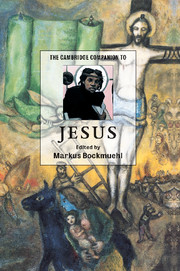Book contents
- Frontmatter
- Introduction
- Part I The Jesus of history
- Part II The History of Jesus
- 8 Sources and methods
- 9 Quests for the historical Jesus
- 10 The quest for the real Jesus
- 11 Many gospels, one Jesus?
- 12 The Christ of the Old and New Testaments
- 13 Jesus in Christian doctrine
- 14 A history of faith in Jesus
- 15 The global Jesus
- 16 Jerusalem after Jesus
- 17 The future of Jesus Christ
- Bibliography
- General Index
- Scripture Index
17 - The future of Jesus Christ
from Part II - The History of Jesus
Published online by Cambridge University Press: 28 May 2006
- Frontmatter
- Introduction
- Part I The Jesus of history
- Part II The History of Jesus
- 8 Sources and methods
- 9 Quests for the historical Jesus
- 10 The quest for the real Jesus
- 11 Many gospels, one Jesus?
- 12 The Christ of the Old and New Testaments
- 13 Jesus in Christian doctrine
- 14 A history of faith in Jesus
- 15 The global Jesus
- 16 Jerusalem after Jesus
- 17 The future of Jesus Christ
- Bibliography
- General Index
- Scripture Index
Summary
From the very beginning, the Jesus Christ of Christian faith has been also the Jesus Christ of Christian hope: not only the one who preached and practised the kingdom of God, not only the one who was crucified, not only the one who was raised from death and exalted to participation in God’s sovereignty over all creation, but also the Christ who is to come. One of the earliest Christian prayers that have survived and certainly the earliest Christian prayer to Jesus Christ that has survived is the Aramaic prayer Maranatha, meaning ‘Our Lord, come’. It was so significant that it was evidently still used in its original Aramaic form in Paul’s Greek-speaking churches. Paul, writing in Greek, quotes it in Aramaic (1 Cor 16.22), and it survives, also in its Aramaic form in an otherwise Greek prayer, in the earliest eucharistic liturgy that has come down to us (Didache 10.6). Translated into Greek, it forms almost the last words in the Bible: ‘Amen, come, Lord Jesus!’, where it is a response to Jesus’ own promise, ‘Surely, I am coming soon’ (Rev 22.20). Even in the Gospel of John, despite its reputation for emphasising ‘realised’ at the expense of future eschatology (where ‘eschatology’, in the language of biblical scholars and modern theologians, refers to God’s final completion of his purpose in history), Jesus’ last words are: ‘until I come’ (John 21.23).
- Type
- Chapter
- Information
- The Cambridge Companion to Jesus , pp. 265 - 280Publisher: Cambridge University PressPrint publication year: 2001
- 2
- Cited by



